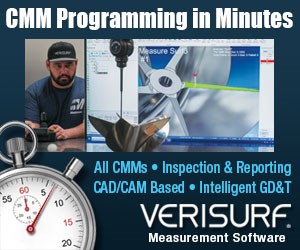INSPECTION & MEASUREMENT

Inspection and measurement equipment includes all of the tools and devices used to verify that mold and part dimensions conform to the tolerances required by the part’s design.
Narrow by Inspection & Measurement Product Category
FAQ: Inspection & Measurement
How can moldmakers digitize a part for inspection?
The first step of digitization in molding is 3D scanning the part. 3D data can be easily captured on site, and users benefit from swift run times, low cost, efficient handling and easy communication. The second step is processing the 3D scan data into CAD data by converting the point cloud generated in the 3D scan into CAD/CAM-capable data. The processing of the STL data produced by the 3D scanner is then reconstructed in CAD.
The part’s characteristics can be recognized based on the scan points, and these points can be replaced with CAD-capable surfaces. This process is called surface reconstruction. With the finished data of the CAD/CAM solid model, the mold build can start.
Traditional mold measuring methods are generally done manually using contact measuring tools such as vernier measuring tools or micrometers. A few attributes, such as mold width, height and depth, can be measured, while the surfaces’ curvature and concave surfaces are challenging to measure. These measuring methods can be complicated and time-consuming and make it challenging to ensure large mold measurements’ quality and accuracy.
So, noncontact 3D scanner measurement is gradually becoming one of the primary mold inspection and measurement methods. There is a wide array of 3D inspection tools powered by different scanning technologies. For example, blue light 3D scanning. This process precisely captures small and filigree details of small- to medium-sized objects rigidly requiring persistent performance in their product lifecycle.
(Source: Breaking Down 3D Scanning in Moldmaking)
How can automation improve overall shop floor measurement?
Shop floor inspection can be a tedious or relatively innocuous part of daily operations, depending on the measurement and analysis methods shops use. However, automated measurement equipment solutions, comprising a CNC coordinate measuring machine (CMM), flexible part fixturing, and automated part handling systems, enable operators to quickly and easily change the configuration in hours versus days to accommodate completely different or redesigned parts on the shop floor during production.
The automation also eliminates the need for dedicated measurement equipment for each mold, mold component, or even molded part, while simultaneously streamlining the analysis and storage of measurement data into smart systems. A smart system combines computer-integrated manufacturing, high levels of adaptability, rapid design changes and digital information technology to achieve a system that monitors the entire process.
For example:
- Equipment status
- Working time
- Idle time
- Maintenance
- Process stopped, the attention required
- Equipment condition
- Preventative maintenance
- Potential component failure predictability
- Measurement data management
- Monitoring for compliance with manufacturing design
- Process control for constant adjustment feedback
- Historical data archiving
(Source: Improve Overall Inspection with Automated Measurement)
What should moldmakers consider when choosing a measurement system?
Cost and value are important considerations when determining the value of one measurement solution over another for a particular application. However, a more essential consideration is the type of part or mold that needs to be measured and measurement turnaround time. For example, a company is building molds for a component that is the size of a soda bottle. For quality inspection, what is the fastest approach? What is currently being used to inspect molds, such as hand gages or traditional CMMs for tactile measurements?
Further considerations include the measurement task at hand. Is it a mold’s surface geometry or points or features? How can this data be moved toward process inspection? Does the application require 100-percent surface coverage that can be captured using a 3D optical scanner with a larger field of view? Does the operator need to verify a small, concentrated area of a mold, which is an ideal application for a flexible and portable measuring arm? Are accurate baseline scans of molds needed, or is it a reverse engineering job? Once these needs are clarified, a moldmaker can better determine the appropriate technology to address its multi-faceted measurement and inspection requirements.
No matter what the solution is, the metrology options today are light years ahead of yesterday’s tools, with easier-to-use software and hardware interfaces. But there is more to the story than that. 3D data-driven processes integrated throughout the product development cycle are the wave of things to come in the smart factory, and that includes metrology. Inside the smart factory, systems will continuously collect and process data during production operations, providing speed and confidence for fast decision-making and rapid responses to shopfloor issues. Moldmakers who embrace a digital thread will make their operations more flexible and adaptable for a new level of quality control.
(Source: Data-Driven Quality Control)
Get Listed!
Thousands of people visit this Supplier Guide every day to source equipment and materials. Get in front of them with a free company profile.










